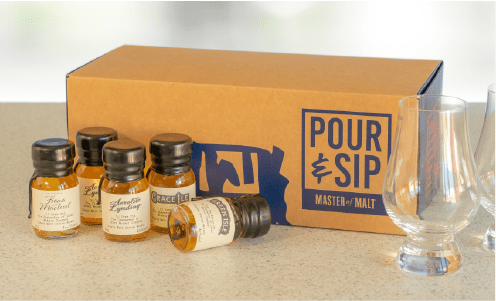A few weeks ago I was approached by Domhayn, who thought I would be interested in their novel finishing techniques. After a bit of research on their website, I was intrigued enough to ask if it would be possible to do a side-by-side trial against the same spirit which had undergone a traditional maturation.
A few days later, two samples of ‘spirit drink’ marked A & B arrived in the post. The only information I received was that one of the samples was of a spirit that had been placed in a sherry seasoned oak cask and left to mature naturally. The other sample was of the same spirit, placed in the same type of cask, but which had then undergone their innovative ‘evolution by diffusion’ process. No information was given on the type of spirit or which sample was which.
The process involves taking the cask and lowering it into the depths of a Scottish loch, where the pressures involved impact the way the cask interacts with the spirit and the environment. More information on the process itself can be found here
Sample A
Appearance: Burnished gold with a noticeable haziness, forms a thin line which falls slowly as thick, oily legs
Nose: Stewed apples, lemon and lime citrus, boiled fruit sweets and cherry cola. Soft hints of mocha coffee appear with time in the glass
Palate: Soft and creamy, almost like an ice cream. Tropical fruits, cereal, mild nuttiness, a soft herbal note and gentle warmth.
Finish: Slightly artificial tropical fruit notes remain, together with candied Angelica, light oak spice and a touch of astringency.
Sample B
Appearance: New gold without the haze seen in Sample A, forms a thin line which falls slowly as thick, oily legs
Nose: Light and fruity, stewed apples, bananas and grilled pineapple, Key Lime pie and Maynard’s wine gums
Palate: Soft creaminess with a touch of astringency. Tropical fruits, nutty oak, soft caramel, cereal, lime citrus, vanilla, a touch of saltiness, herbal bitterness, honey, damp earth and cinnamon warmth.
Finish: Honey, candied Angelica, mild mustiness and just a touch of cinnamon spice.
Sample B was lighter and cleaner in flavour than sample A. The artificial nature of the tropical fruit note has gone, to be replaced by more of the citrus and cereal notes.
Although at the time I was unaware of the type of spirit involved, my thoughts were that many of the notes were reminiscent of a young grain whisky.
I contacted James at Domhayn shortly afterwards with my thoughts and notes, at which point I was told Sample B was the sample that had come from the loch and that the casks previously held a blend of PX and Oloroso. I was also told the nature of the spirit itself, but was asked not to share that information for others who wanted to try this for themselves.
It’s safe to say that every cask is different, so the spirit obtained for each sample would differ, but it certainly feels like the process has resulted in more than a subtle change.
It would appear from the website that the casks are small, possibly Octaves, and are sometimes only submerged for a matter of minutes, so is it just a case of the pressure changes on the wood seen during submersion and subsequent emersion that are causing the spirit composition to be altered? It certainly seems plausible that compounds are released from the wood at higher pressures and others pulled back in as the pressure is reduced, accelerating the chemical processes normally seen during maturation, but are they the same compounds and chemical processes?
Another obvious question would be whether water is able to enter the cask under these pressures, in this case the abv’s in both samples seemed pretty low so it would be difficult to tell.
It remains to be seen what the SWA think of the process, and how they would categorise it. Maturation would suggest ageing of the spirit had occurred, even if the end results are broadly similar the path to get there is very different. It’s also likely the process will result in differences in the final composition compared to a traditional maturation. Modification or alteration by hydrostatic diffusion may be the more accurate term but it’s a bit of a mouthful and doesn’t really capture the imagination in the same way as the mystique and magic of maturation in a dunnage warehouse.
I’m also struggling to see how this could be seen as a large-scale commercial venture, with limited casks and less than 72 bottles from each cask. However, it would be unfair to describe this as a gimmick, each cask is supported by chemical analysis of the finished spirit and this type of experimentation appeals to my background in science. It’s certainly interesting, and may even provide more insight on the interactions seen between cask and spirit during normal maturation processes.
I would imagine many of the bottles will be kept as curios, but that would be a shame. After all, it’s not often you get to drink a spirit that has been to the bottom of Loch Ness.
For more information on Domhayn and the process involved, click on the logo below.






